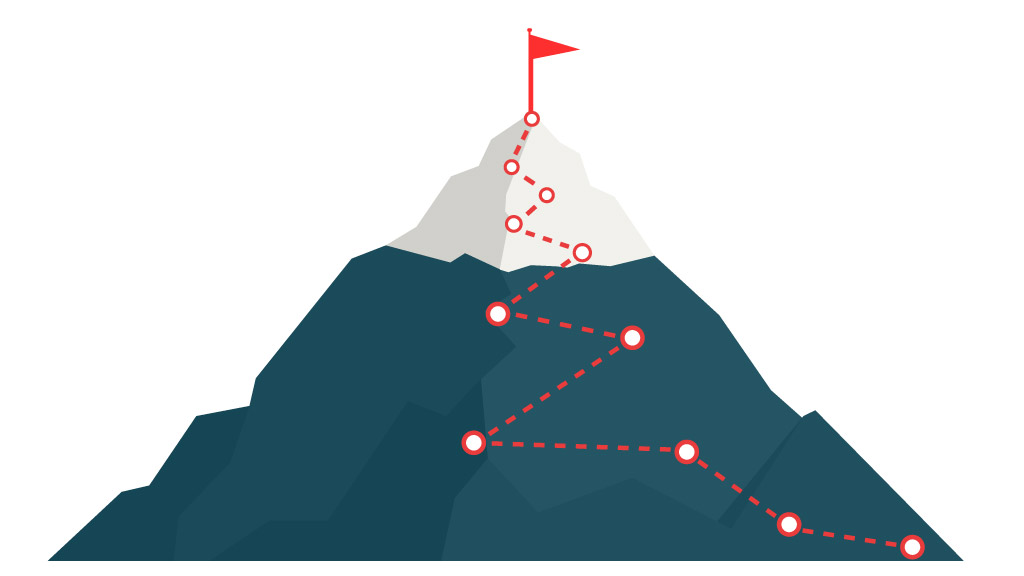
We’re excited to announce that Planview has built Objectives and Key Results (OKRs) capabilities into Planview AgilePlace™!
In this post, you’ll learn:
- why we’ve added OKR capabilities into the Planview platform
- why OKRs are particularly valuable for Agile organizations
- how OKRs have changed in recent years
- what to look for in OKR software
But first, here’s a quick introduction to OKRs, in case they’re new to you.
OKRs in 30 Seconds
Pioneered by Intel in the 1970s, OKRs were designed to help people make their ambitious goals more tangible, manageable, and measurable.
Since then, OKRs have become the go-to goal management framework at many companies. Google, for example, recently used OKRs to outline their sustainability commitments.
In our view, the power of OKRs is its focus on driving value-based outcomes geared towards creating customer value.
As more companies are making the shift from projects to products and scaling Agile throughout their organization, OKRs are playing an essential role in the success of a company’s transformation journey.
Talking OKRs with Patrick
Leading up to the release of OKRs in LeanKit, we sat down with Planview Chief Product Officer Patrick Tickle to talk about OKRs. Here’s what he had to say.
How have OKRs evolved to having a renaissance of sorts today?
Patrick: “The OKR model has been around for decades but has seen new life in the last few years. In its newer evolution, it is a framework for setting strategy and defining outcomes for organizations on the journey to scaling Agile.
A major reason is the growing adoption of Lean-Agile delivery practices and the need to ensure on-strategy delivery as companies reach new stages of scale. As our customers know, it’s challenging to scale Agile and coordinate value delivery across a multitude of Agile teams.
Adding more fuel to the fire is the emergence of OKRs in the Scaled Agile Framework® (SAFe®). SAFe has risen in popularity and is rapidly being adopted as a guide for scaling Agile.
The inclusion of OKRs as a means of setting Strategic Themes at the portfolio level in the latest version, SAFe 5, was significant in terms of OKRs crossing the chasm.
Now, a mechanism exists in SAFe to help ensure work links to organizational strategy in a more meaningful way – that is, by striving for outcomes rather than outputs. Though lagging indicators such as key performance indicators (KPIs) still have a place, OKRs represent a shift to measuring the true value being delivered, which will have a more direct impact on a company’s top-line goals.
This outcome-centric approach embodies much of the philosophy that has driven Agile adoption since the Agile Manifesto was drafted in 2001.”

What are some of the benefits of OKRs?
Patrick: “The OKR framework is an effective way to ensure that your enterprise is delivering work that matters to the business. It’s oxygen for organizations that want to become more product-centric and value driven.
OKRs support Agile delivery’s focus on outcomes – the products, services, and experiences that drive revenue and growth. The system promotes the transparency and accountability needed to drive those outcomes.
Within OKRs, leaders can set the strategic priorities and objectives to ensure an organization is on strategy both vertically and horizontally.
But instead of hindering autonomy, the OKR framework supports it by letting Agile teams set their own goals and decide how to achieve them. OKRs also provide a faster way to track progress as the work is being done and make timely course corrections.”
What role does OKR software play in the adoption of OKRs?
Patrick: “It’s one thing to talk about implementing OKRs but quite another to actually do it. The framework can require organizational change to deploy and maintain, especially across all levels of the organization.
Operationally, OKRs belong right in the strategy-to-delivery pipeline. This is where purpose-built OKR software comes into play. If it’s tied tightly to delivery, OKR software can help move the needle for many organizations.”
What qualities are important to look for when choosing OKR software?
Patrick: “OKR capabilities should be closely connected to where the work is planned, tracked, and managed. When OKRs are isolated from the work being done, it’s easy to lose track of what objectives you’re trying to achieve. It should also be easy to use.
In addition, OKR software should foster the transparency that an Agile organization needs to move fast, pivot quickly, and deliver customer value.
This includes supporting unified goal setting, where representatives at different levels of an organization participate in the act of setting OKRs with respect to their teams, as well as the overarching objectives of the business.
With that approach, goals are easily understood up, down, and across the organization. This is important for getting everyone on the same page and staying there, even as things change.
Another capability to look for is a clear line of sight into all connected work, including shared objectives and interdependencies. With this visibility, leaders and teams can set objectives effectively, understand progress against plans, make shifts in resources and funding, and address any bottlenecks that present an issue.
And when pivots are made, an entire organization can ensure their efforts are aligned, through and through.”
Why has Planview built OKR capabilities into its platform and what is the value to customers?
Patrick: “Customers around the world use the Planview platform to rewire strategy to delivery. The OKR framework is becoming part and parcel to this mission.
By building OKR capabilities directly into our platform, we aim to help our customers in three big ways.
First, we want to help them unite goals and value delivery inside a single solution.
Second, we want to help them support unified goal setting to foster autonomy and encourage a clear connection between short-term objectives and long-term strategy.
And third, we want to help them understand shared objectives and interdependencies that require vertical and horizontal synchronization.
It’s a very powerful thing when all teams can execute and achieve results in context with the larger organizational strategy in mind. ”
Watch now: Objectives and Key Results Demo in Planview AgilePlace
Stay on Strategy and on Target with OKRs
There it is: OKRs provide a better, more modern way to support some of the central ideas of scaling Agile, make the project-to-product shift, and focus on delivering value.
Whether you want to adopt the OKR framework or expand your use of it, the OKR capabilities in the Planview platform can help maintain clarity and focus on what needs to be achieved – and get it done.
For more information about the new OKR capabilities within Planview LeanKit, watch the demo here. If you’d like to learn more about OKRs, understand the differences between KPIs and OKRs, or see more examples, then check out our comprehensive guide.

![451 Research Perspectives on Agile Program Management [Video]](https://blog.planview.com/wp-content/uploads/2020/11/451-Video.gif)


